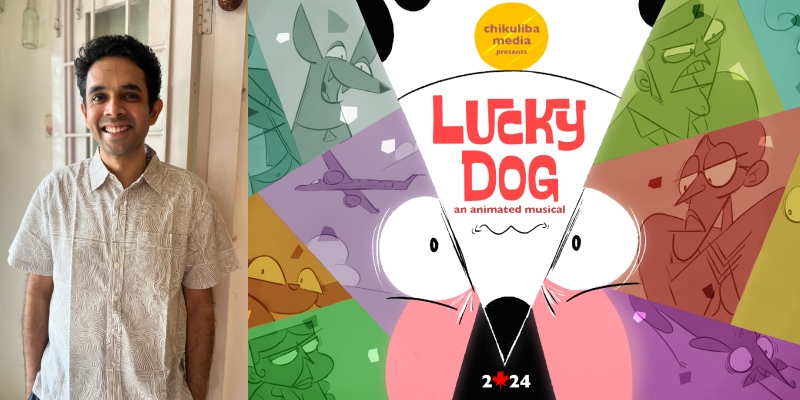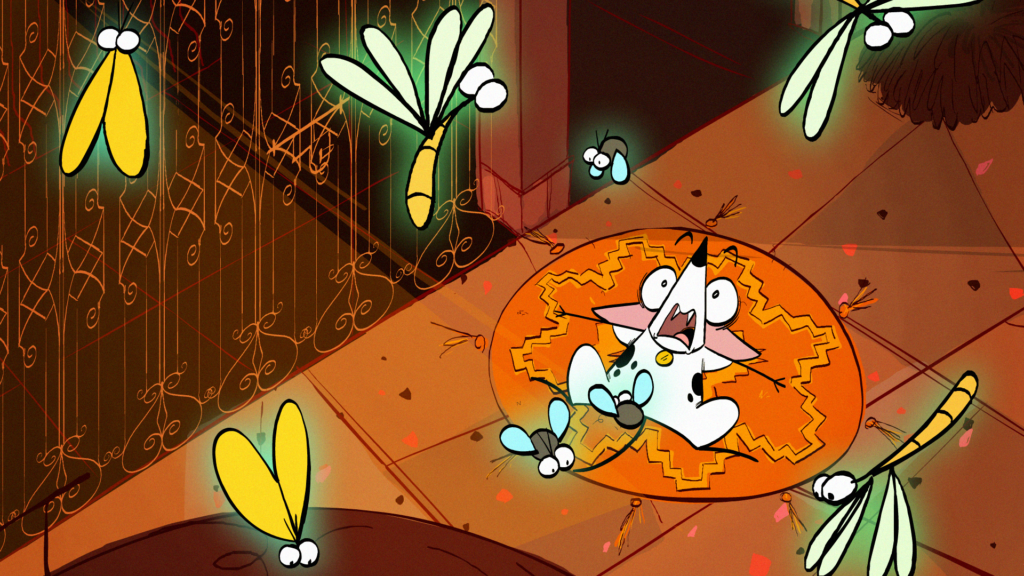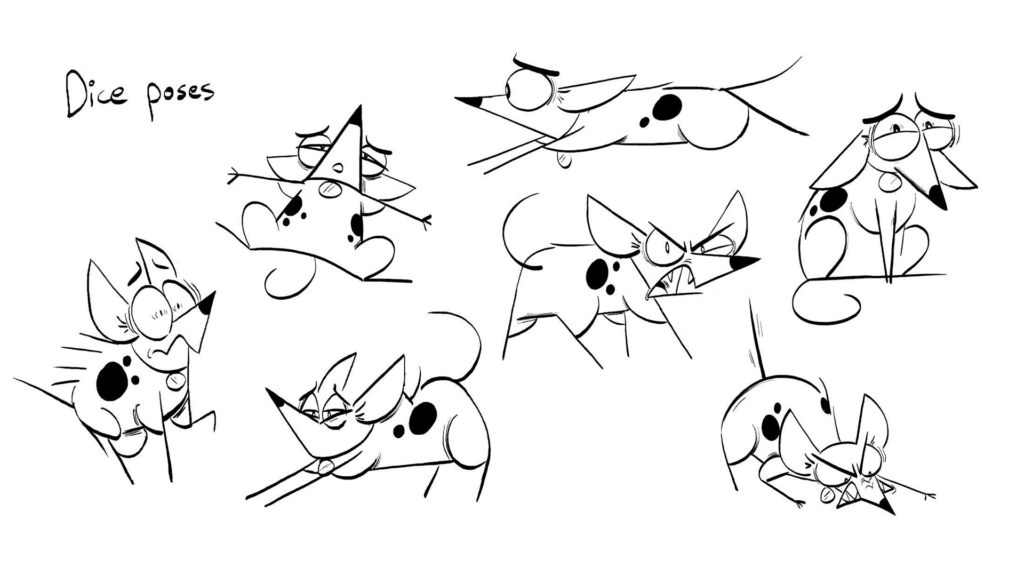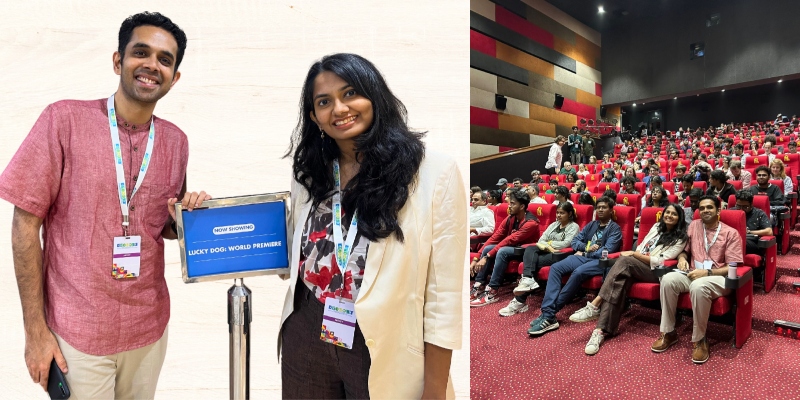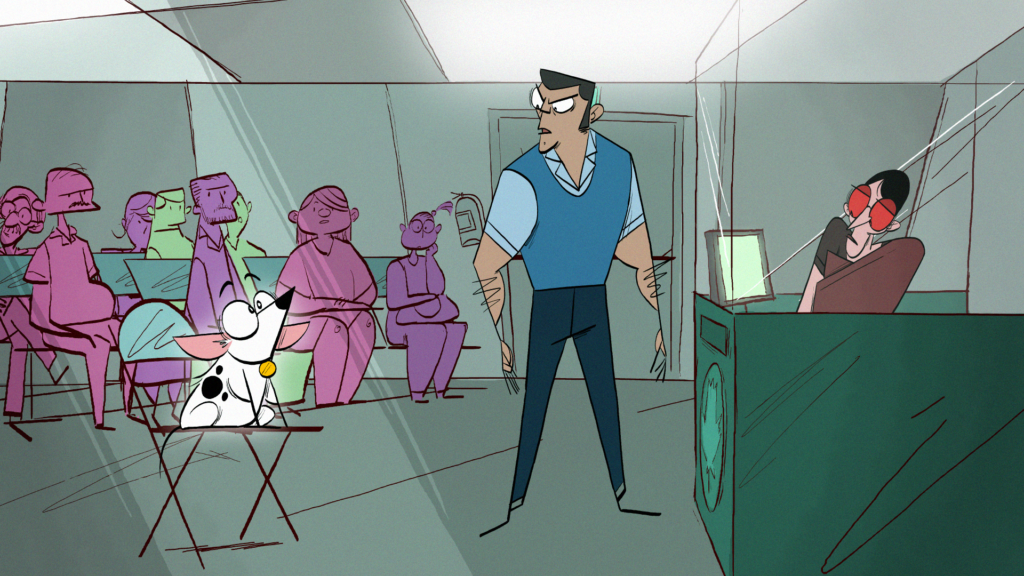Back in 2016, the now independent animation filmmaker Ujwal Nair wanted to immigrate to Canada but was denied a visa. Around the same time, one of his friends moved to Canada with five of her cats. Nair couldn’t help but find the situation ironic; while his own visa application was rejected, the feline companions were granted entry. “I thought – Why do they get to live in Canada? They don’t even know what Canada is!” Nair humuoursly reflects. Yet, this whimsical disparity sparked a thought – “What if Indians are so obsessed with going abroad that it rubs off on their pets?” This intriguing notion laid the foundation for Nair’s third animated short film Lucky Dog.
Lucky Dog is a 2D animated musical that tells the story of Dice, a pet dog that wants to immigrate to Canada. The film had its world premiere at Animela – India’s international animation, VFX, gaming, comics and XR festival which took place from 19 to 21 January 2024 at NFDC, Mumbai. The premiere saw a full house; so much so that when all seats were occupied, attendees sat on the theatre stairs to watch the film.
In many ways, Lucky Dog can be called a tragicomedy. Dice, who has it all but still wants more, makes for a character that in many ways represents human emotions. But what got our attention is the way his story is weaved in songs, and how through songs, other characters too get a voice in the story.
AnimationXpress caught up with Nair to speak about how he independently produced Lucky Dog and the creative process behind making it. Below are the excerpts from the interview:
Can you explain the process from the drawing board to animating this film? What was the research and the kind of references you picked?
The film took four years to make. I wrote the story outline followed by the lyrics and screenplay in 2020. In 2021 my co-producer and wife, Indou Theagrajan, came on board and we hired Aditi Ramesh, our composer. Aditi composed the music while I worked on the visual development and storyboard. In 2022, we received the final mastered tracks and I completed the layouts, animatic and rough animation. In 2023 we completed the clean-up, backgrounds, compositing and sound. As is the case with most productions, the final stretch was the most intense.
For the script, I took inspiration from stage musicals like The Book of Mormon, Lin-Manuel Miranda’s Hamilton and musical comedy acts by Tim Minchin and Bo Burnham. Those were some of the references I shared with Aditi as well. For the visual aspects I was influenced by the work of Brad Bird, Genndy Tartakovsky and Cartoon Saloon.
This is your first musical, and it was thoroughly entertaining. Why the choice to make the film a musical? Having never done a musical before, how did you prepare for this one?
Thank you! The structure of the film was such that the dog had to provide a lot of backstory. Doing it through voice-over was an option but I wanted it to be more exciting. I was drawn to musicals because I enjoyed the wordplay and wanted to bring that element to the writing. This is an emotional story with ups and downs so I thought music could elevate the emotions of the film.
Before writing the lyrics, I got a basic understanding of song structure. I learned what a verse, chorus and bridge were. To break the monotony from one song to the next, I played around with the lengths of the verses while being conscious of the syllable count in every verse.
We hired Aditi at the beginning of pre-production because I wanted the songs to be in place before I storyboarded the film. The songs were going to impact the pacing of the film so along with the final script and lyrics, I gave Aditi detailed briefs for every song. This included how long each song needed to be, the tonal shifts in the songs, the changes in pace. I mentioned where I wanted musical interludes with no vocals, where I wanted silence, where I wanted lines to be spoken rather than sung. I was concerned Aditi would find it overwhelming but she welcomed it. Along with her skilled team of musicians, she delivered a soundtrack that hit all the right notes.
Tell us something about designing the characters in the film, especially the dog – Dice.
Since this was a 21-minute long film with multiple characters, I went for a simple and stylised approach to the character design. I wanted the characters to be interesting to look at and somewhat easy to draw. Luck plays a big role in the dog’s life so I named him Dice and based his appearance on a playing dice – white with black spots. His triangular shape allows him to keep his nose up in the air, which felt appropriate for his character because he’s a bit snooty and thinks he’s better than everyone else!
How many people have worked on this film?
A team of 18 has worked on the film. The music team comprised eight artists. The sound and foley team consisted of five artists, led by our sound designer Dinesh Kumar. The animation team consisted of three cleanup and in-between animators – Subhajit Kar, Suman Manna and I; and one animation colourist, Labani Ganguly. Indou and I co-produced the film. We brought one of my favourite animation filmmakers Krishna Chandran on board as a consultant to help guide us through the production process.
The goal was to keep the team small because the project was entirely self-funded. In order to do that, I took on most of the visual art requirements including visual development, storyboarding, rough animation, backgrounds and compositing.
Indou, your wife, has been an integral part in the making of this film. What did her role encompass?
From day one, Indou believed in the film and she was determined to help any way she could. She has a background in fashion and manufacturing and she brought her managerial skills to this project. She was instrumental in budgeting, making schedules, file management, creating and maintaining tracking sheets, being a sounding board for creative ideas and thinking on her feet in difficult situations. It’s great to have a partner who is as invested in my creative pursuits as I am.
You have produced this film independently. Can you share the process and challenges for producing films independently?
Lucky Dog is the third animated film I’ve written, directed and self-financed (my second film, KPL, was featured in AnimationXpress in 2019). In my previous productions I did almost everything myself so the financial cost was not a factor. Lucky Dog required a variety of skills and more time and effort to produce so I had to hire artists to help me make it. It ended up costing quite a bit of money.
The biggest challenge in making an independent film is the lack of funding. However, I really enjoyed having time and creative control to make the film the way I wanted. Apart from decent budgets and possible limits to creative freedom, I think the process of producing an independent short film is not that different from producing a film for a studio. Both require discipline, skill, strong will and an appetite for collaboration.
Also, we were very systematic in our approach to production. We followed the well established animation pipeline and it worked in our favour.
How did you fund this film? And how do you plan to monetise it?
At the beginning of pre-production, we applied for a few art grants because we didn’t come across many grants for films or animated projects. But that didn’t work out. At some point, I realised that if I wanted to get the film made, I had to finance it myself. I was getting a steady income from my day job and I had some money saved up. I decided to spend most of it on this film.
We allocated a significant portion of the budget to the music and sound and with the money that was left, we hired a couple of animation artists. As with my previous shorts I took on a majority of the visual art roles to keep costs down.
We would love to monetise the film but we don’t have a clear plan for that at the moment. Right now we are focused on getting as many people to see it as possible. If nothing else, we hope this film helps us get funding for our next project.
From an idea to turning it into a film, how has your journey been?
It’s been exciting and rewarding but there were times when it was very challenging. We had our share of setbacks and moments of self-doubt. But even when things got really difficult, I had to acknowledge what a privilege it was to be able to self-fund and work on a passion project.
After the world premiere at Animela, what was the response to Lucky Dog?
The premiere was exhilarating. You were there, you saw how packed the theatre was! I couldn’t believe it. And to hear all the positive things people had to say after the screening was very special. I was thrilled that my parents and our lead voice-actor Clyde Rodrigues could make it. It was also fun to eavesdrop on conversations about the film when we walked around the NFDC campus. That was a real treat. We are so grateful to Team AniMela and Anne Doshi, the festival director, for the experience. For us, it was the best way to celebrate the completion of the film.
Where is Lucky Dog going next? What are your plans with this film?
We are in the middle of submitting to festivals around the world. Although the film is personal, I believe it deals with universal themes and I think it has the potential to resonate with a diverse audience. Let’s hope it travels far and wide!
What is brewing next?
I’m excited about the prospect of making a feature film. I’m eager to get back to writing! Although it can get frustrating, for me it’s one of the most rewarding stages of the filmmaking process.

